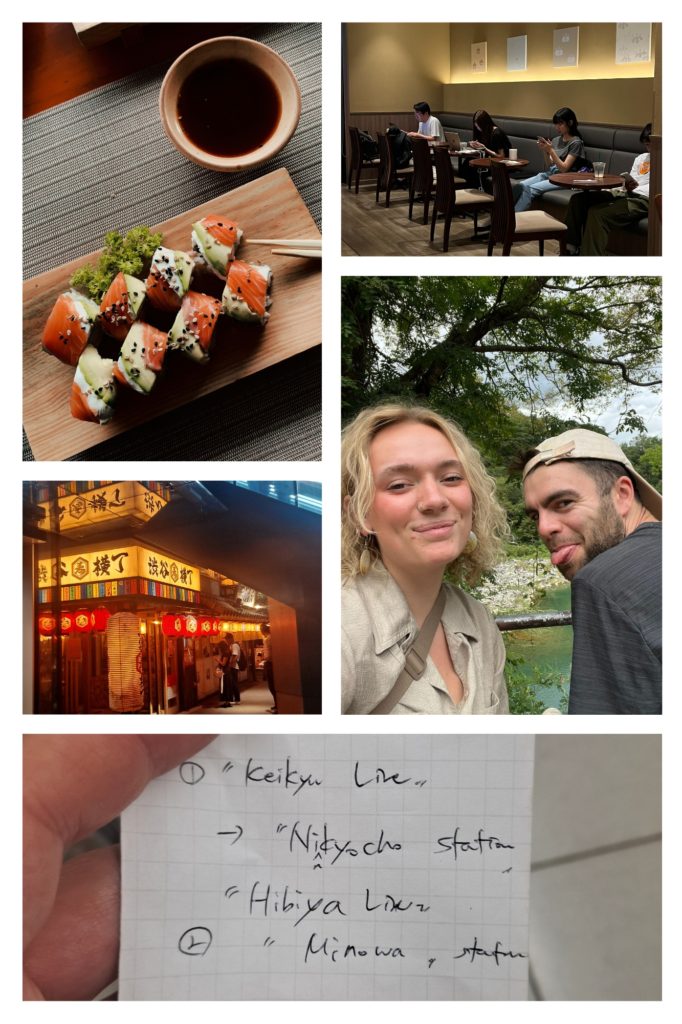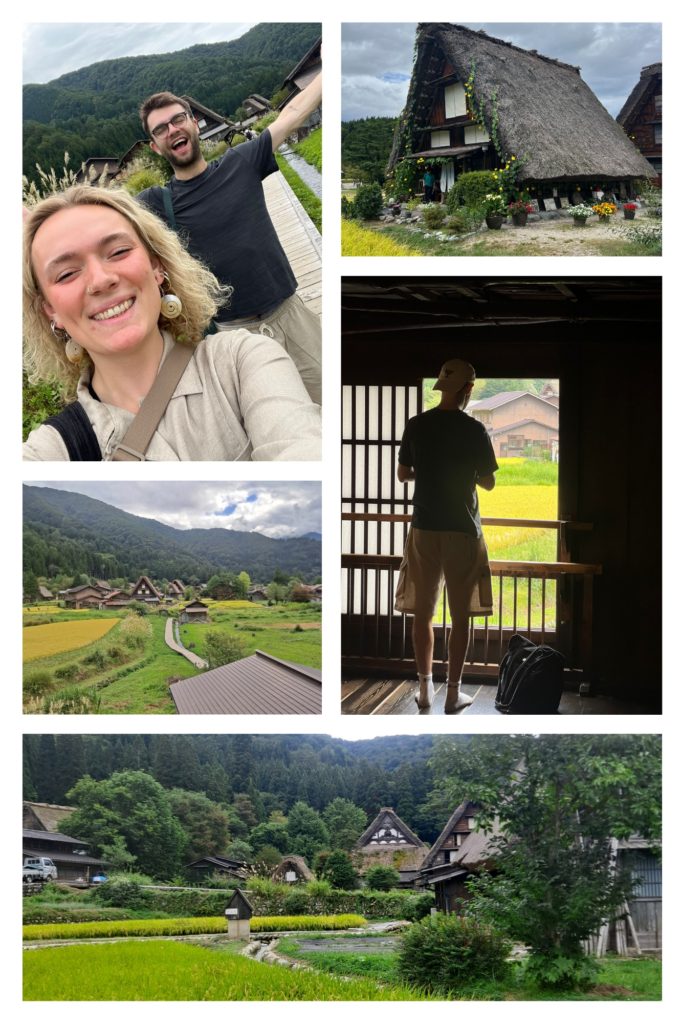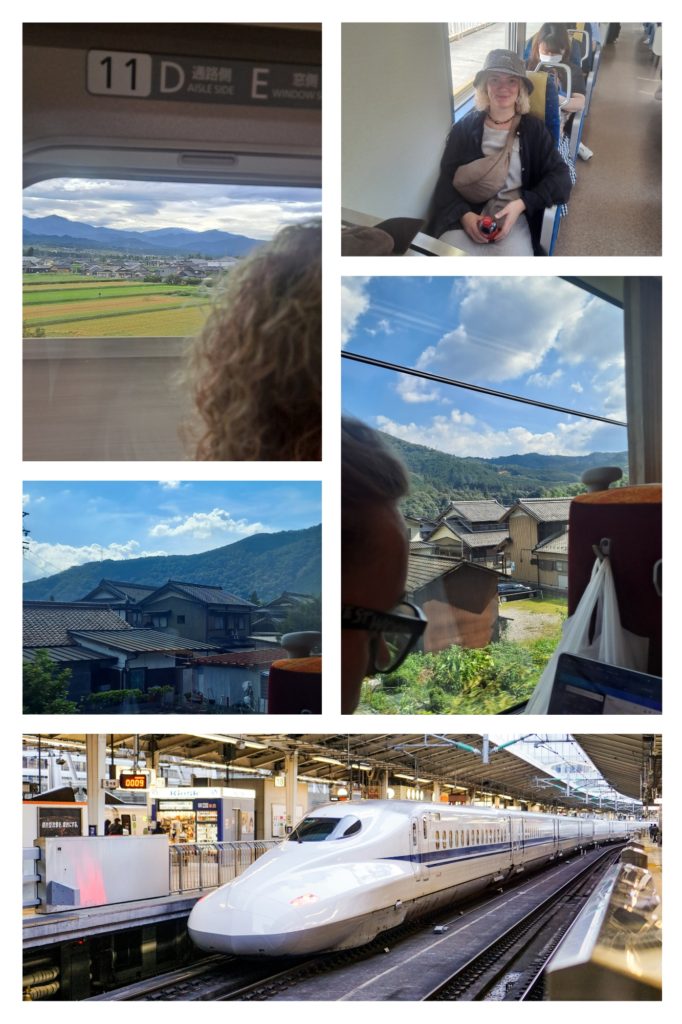Japan feels unique. Bubbling nerves and heart-thumping excitement accumulate in the weeks up to departure, unlike any other trip. The prospect of an immense journey, the inability to communicate the language, and the flashing colours of Tokyo scare many people off. But not me and my partner: Mia. We love chasing change – and Japan was calling both our hearts. But since we’re both self-employed, taking almost a month off work completely wouldn’t have been wise for both our businesses; so we decided on a workcation: meaning we would work remotely in Japan while travelling. This blog is the story of our 24-day adventure.
Why did we choose to travel and remote work in Japan?
Japan has enchanted me since the COVID lockdown in the UK. Stuck inside: I entered Japanese author Haruki Murakami’s immersive novels about a protagonist wandering Tokyo; I ordered mountains of sushi; watched Japanese short films – and then started writing about the culture for online culture sites. Despite my success (my articles were popular), I hadn’t been to Japan. So when I left my office job in London to unlock more of the world through remote work – I immediately booked Japan at the end of 2022 for September 2023. Mia, on the other hand, came into my life shortly after – and by the time Japan arrived – I couldn’t imagine going without her.
Arriving into Tokyo

We landed in Tokyo just before 7 am on 7 December 2023 after an overnight flight – and spilled out into Tokyo Haneda Airport bleary-eyed and begging for a shower.
I’d picked up shingles only days before our trip – and this painful, itchy skin rash (similar to chickenpox) had me wriggling in my seat for almost 12 hours. Mia, meanwhile, interchanged between looking at me sympathetically and sleeping. She had never travelled this distance before. We were delirious. And so arriving to a frenzy of colours, Japanese kanji signs and stoney-faced morning commuters was an overload on the senses (it took 20 minutes just to figure out how to take cash out!).
Tokyo’s Taito City was our goal — about 35 minutes north via train. So we examined the underground map like an ancient scroll – scrambling our remaining brain cells together. Just as we were about a pass out – our saviour entered. A smiley local woman approached us with a Cheshire cat grin. After asking where we were going, she then slid out a piece of paper and pen and wrote two possible routes on a piece of paper to guide us there. This set the tone for the kind hospitality the whole trip.
Essential tips: Workcation Checklist — How to prepare for a productive and stress-free trip
How to mix adventure with working remotely in Japan
27 hours after leaving London – we collapsed into our AirBnb. After a brief lie down, we ventured outside and wondered what planet we’d landed on. Walking at night was magical: the eye-searing bright lights; colourful noren curtains (暖簾) outside restaurants; and the thick soupy air underneath sky-high buildings. We were too amazed to speak – and the heavy jetlag felt like walking with ankle weights.
The next day – we decided to explore during the daylight, and then work remotely in the evening. This meant using the time difference (being 8 hours ahead of UK time) to our advantage; adventuring in Tokyo while the UK slept without worrying about missing calls, and then tuning in during their working day (our evening time). We arrived at the sumo wrestling stadium at 8.30 am and were in awe of the quiet, spiritual atmosphere. Naturally, we then visited a dog café and raided the famous UNIQLO.
At 6 pm – our first sushi adventure began. We then slid under a Noren curtain and appeared in a tiny restaurant as the only guests. The hosts greeted us and sat us on the counter, opposite rows of sashimi so fresh they could glow in the dark. The owner’s wife was sitting in the corner cutting her toenails as a Japanese baseball ticked away on the tiny TV screen nearby. We didn’t know what to expect… But the nigiri had us moaning with every bite.
We then both logged on from our Airbnb to work remotely from Japan. Mia runs a booming textile design business (MiaSylvia) – and she had to direct and manage her team as they curated majestic textile installations at weddings and events in the UK. Me? I was searching for a full-time writing role after a year of extended travels. So we were both online at 10 pm Tokyo time (2 pm London time). Mia – on calls. Me – an interview with a future employer.
Do I need a Japan remote work VISA?
Your unique work-life decides whether you can work remotely from Japan. (But spoilers: there’s a good chance).
- Japan’s digital nomad visa enables citizens of 50 countries to work remotely in Japan for up to 6 months.
- Japan’s working holiday visa enables 18 to 30-year-olds from 19 countries to mix work and play in Japan for up to 12 months. This encourages remote workers to finance their adventures through workcations.
Can I work remotely in Japan on a tourist visa?
At the time – me and Mia we entered on a tourist visa in September 2023 (a maximum stay of 3 months) and worked remotely. However, that is not acceptable in 2024. There’s been a welcome boom in visa options this year as Japan wants remote workers to boost its economy.
Wandering and remote working in the Japanese countryside
Being in nature nourishes our creativity and love. So after 3 days in Tokyo, we ventured north to Nagano. Here, we nestled ourselves in a cosy ryokan (traditional inn) on a ‘nakamise’ – the street leading to Zenkoji Temple. After both sending emails from our shikibuton (futon bed), we roamed the 1400-year-old temple grounds, admiring history and saying prayers as the incense tickled our nostrils. Next: back at the ryokan, we both sunk into gendered onsens (hot baths heated with geothermal water) to exhale and reflect.
Later that evening, as the only foreigners in a tiny local restaurant – the owners welcomed us like long-lost friends and recommended three delicious dishes. We got on so well that the chef gave me a cooking bandana as a gift while holding up her phone to reveal 3 words via Google Translate: “It suits you!”
This is an unforgettable adventure, we said to each other.
Next – Shirakawago

A bus ride through lime green, patchwork fields landed us in Shirakawa-go in Gifu Prefecture. We had both sent work messages during the ride, so it was now time to explore. This UNESCO heritage site explodes colour from sky-high green trees that peer down over 300-year-old, gasshô-zukuri thatched houses. Made from wood and straw without any nails, gasshô-zukuri are designed to protect those inside from all weather – and they translate to ‘hands in prayer’ in both language and appearance. We also noticed that traditional ways of life are still alive here. For example: locals practice yui 結 – the spirit of teamwork – to re-roof the houses when needed.
Back in our traditional inn, Mia managed challenging work calls – including one client asking ‘Do you have a free hour?’, despite it being 10 pm Japan time. It hit us that the time difference between Japan and our Western world can present obstacles for remote working, but we felt determined to go with the flow and adapt to what we had. We then slid downstairs in our yakata (traditional bath robes) and soaked up late-night miso ramen noodles. The next morning, we sunk into a steaming private hot onsen overlooking the mountains for one of the most romantic experiences of our lives.
Remote working in Japan? Make bullet trains your workplace

There’s no bigger contrast between British and Japanese transport. UK trains and buses are notoriously late, dirty and noisy. Meanwhile, Japan’s equivalents are on time, spotless, and silent. Our journey from Shirakawa to Kyoto offered over 4 hours of productive remote working time. As our lightning-fast bullet train sliced open new countryside views by the millisecond, I extended my legs and realised this was the most comfortable transport I’d ever been on. Next: a train officer walked the length of the carriage, turned around and then bowed before exiting. There’s nowhere like Japan.
Trains and buses were perfect for remote working. In between writing paragraphs and pinging emails, we would peel our heads up to squares of green, yellow and orange-hued countryside. Tractors trotted past, and we wondered who lived in the small wooden houses. Since I do my best work in a quiet and cool environment, the silence and AirCon were welcome. Whereas a hurricane of phone calls and drunk chatter on British transport can make you pray it’s over soon, Japanese transport soothed our nervous systems – especially as we tucked into a gorgeous bento box.
Discover More: Workcation revolutionises the balance between work and play
Cruising around Kyoto
Kyoto came: Japan’s cultural capital. And with that: tourists. Having arrived from the remote countryside, it shocked us that we couldn’t walk into many restaurants and had to book online. Tourists aside, we do things our own way. So we stayed in a 19th-century family home (now an AirBnb). After emails and calls, we roamed the sunset-soaked streets – admiring art and architecture shops, cosy cafes and lively izakayas (Japanese pubs). We sat by the canal, talking, smoking cigarettes, and watching cyclists and walkers flow by, some weaving into the homes in front of us.
The next morning we stepped into a traditional textile workshop to try the 800-year-old practice of Aizome: indigo dying. The silence was powerful as a 90-year-old woman practised on an adjacent table. To recharge: we devoured washoku (a traditional Japanese breakfast made with salmon, steamed rice, miso soup and pickled vegetables) for only ¥1000 (£5.10) at a local eating hole. Mia votes this her favourite meal of the trip!
To work effectively despite the UK-Japan time difference, we spent one evening at Tully’s Coffee in Kyoto. Clearly marked desks welcomed remote workers, alongside beautiful coffee and mood lighting. Open until 10 pm. It hit us that Japan is a wonderful place to open your laptop.
5 important things to consider when remote working in Japan
1) It’s hot (seriously hot)
Our month in Japan was Japan’s hottest September since records began in 1898, which is 2.66°C higher than usual. It meant Tokyo especially was humid and stifling – and we had to manage our energy carefully; often popping into coffee shops and other air-conditioned spaces to rest. In July 2024 – 123 people died of heatstroke in Tokyo. If you’re considering Japan for a workcation, we recommend choosing your month(s) wisely. For example: February to early April and October to late November are cooler times to visit.
2) Vegetarian options are limited
Some bad news for vegetarians and vegans. Most Japanese menus feature meat and/or fish in every item. As two pescatarians, we found it difficult to find meat-free options in some izakayas and other restaurants that weren’t exclusively sushi bars. A lot of menus won’t include a vegetarian option or any labelling, and the staff look at you rather bemused when you ask. Top tip: research deeply in advance and circle your spots.
3) Recycling and sustainability is neglected
It hit us that we didn’t notice a recycling bin in Japan – and many foods in supermarkets were wrapped in single-use plastics. Japan has the world’s second-highest plastic waste emissions per person (with only 22% of collected plastic recycled). The Climate Action Tracker also deemed Japan’s sustainability efforts ‘insufficient’. So for the environmentally conscious like me and Mia: this was a tough scene to watch.
4) Earthquakes are a real threat
Sat on the seismic meeting points of four tectonic plates, Japan and its surrounding area account for 18% of the world’s earthquakes; with tsunamis and typhoons also possible. It’s why Japan’s locals mark Disaster Prevention Day every 1 September with training in schools.
Those intending to travel to coastal Fukui, Ishikawa, and/or Niigata need to be especially aware. And know that a megaquake is predicted in the Nankai Trough in the next 30 years.
5) The jetlag is a monster
‘Are you awake?’. It was the fourth time we’d asked each other. Eyes glued to the ceiling at 4 am, this jetlag had been more disruptive than we predicted – and it follows you like an ominous dark cloud when you get home
We would do it again, but travellers/remote workers should factor this into their schedules. Now, back to our story.
Staying in a 16th-century family home in Fujisan
I love clean air. The kind of air that makes you exhale ‘aaahhhhh’ and smile from the heart up. Saying this: our 24 hours in Fujiyoshida presented the cleanest air we’ve both drunk. Set in the steamy shadows of Mount Fuji, we roamed the countryside, kissed in front of waterfalls, walked in forests and ate delicious local cuisine. Our accommodation was a 16th-century family home where pilgrims used to stay before climbing Mount Fuji. We felt the history with every barefoot step inside here. We wish we’d booked her for longer. But Tokyo was calling.
A final remote work burst in Tokyo

Arriving back in Tokyo after countryside adventures is abrasive but exhilarating. Ebisu – near Shibuya scramble – was our AirBnb home. During our final 4 days in Tokyo – I wrote in our air-conditioned AirBnb to meet a deadline, while Mia continued to manage her relentless email inbox and client calls.
By day we roamed the flashing streets, hunting for vintage records and Vivienne Westwood clothing (Mia’s favourites). We were struck by the glitz and glamour of some of Tokyo’s shopping streets, as well as the cosy, art and indie-store hideouts that magnetised us. When you walk around Tokyo – remember to look up. Layers of lights radiate from buildings high in the sky. You can find a barber shop on the 2nd floor, a dim-light cocktail bar on the 10th. We even ventured up to a food hall high in the Shibuya skyline to soak in the views. Tucked into the colour, coffee shops also stayed open late – housing lightbulbs of laptop-workers until 11 pm. They say New York is the city that never sleeps, but Tokyo gave me the feeling that anything can happen both in the city and within me.
To celebrate our remote work successes, we attended a cooking class at a charismatic woman’s home, Yuka. She was a bundle of energy and couldn’t stop smiling the entire time. We made sushi and ate it all up. And Yuka and Mia particularly hit it off talking about textile art.
Flying back to Heathrow after a spellbinding workcation
Flying back to Heathrow Airport was an emotional experience. Reflecting on the magic wonders and unique cultural traditions we’d immersed ourselves in meant we couldn’t stop smiling (and sleeping) and the whole journey back.
Onto the next one.


